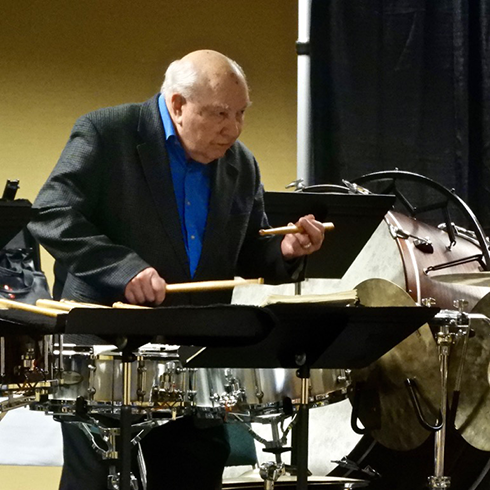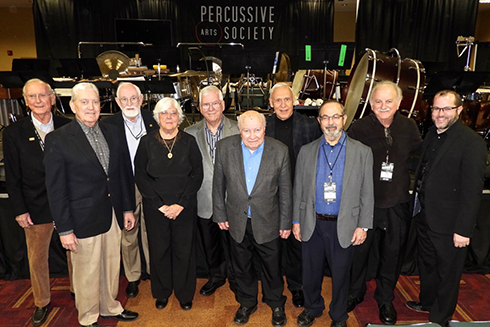Alan Abel – Renaissance Man
Alan Abel – Renaissance Man
by Michael Rosen
May 5, 2020

Alan Abel was a giant in a trim package enriched by determination and youthful vigor. He was as indefatigable as he was generous—a sensitive musician and gentle soul. His exuberant nature coupled with a mischievous sense of humor were appreciated by all who met him. Everything he did, whether it was performing, inventing, building, or heading up “Shine-up Saturdays” at church was done expertly, and never with the expectation of accolades. Alan touched so many lives and was devoted to his family, friends, and his church community. In the Ardmore Presbyterian Church, his wife, Jan, sang in the choir and he provided percussion accompaniment and conducted the handbell group, and both were active in the youth program, which was an important part of his life. He always showed how much he cared about people and accomplished so much good in his 91 years.
Students will remember him, of course, for his brilliant performing skills and his prodigious teaching ability. To be an Abel student was something exceptional. His former students carry his legacy in orchestras and universities all over the world. Students would visit his house in Wynnewood, have an inviting cup of tea served by Jan, and then descend into the “dungeon” for a lesson that was unforgettable for its stores of information, unwavering expectations, and helpful encouragement. He was a mentor who shared his knowledge with everyone. His accomplishments define the title “Renaissance Man”: he was a carpenter (as was his father before him), an electrician, an inventor, an author (repertoire texts), a sailor, golfer, gardener, card player, puzzle master, and an all-around fix-it guy ready to help at a moment’s notice.
Alan was a Hoosier, born in Hobart, Indiana in 1928 to Daniel Abel, a carpenter, and Wilma Reynolds, who was a professional singer and teacher of voice. His brother, Bruce Abel, is a professional singer living in Stuttgart, Germany. Alan started his journey as a member of the Hobart Championship Band (1947), went to Eastman, graduating in 1951, and joined the US Air Force Band.
After his military service he played with the Rochester Philharmonic (1947–51), the Oklahoma City Philharmonic (1951–59), and finally joined the percussion section of the Philadelphia Orchestra in 1959, becoming assistant principal in 1972 and associate principal in 1988, and he was a key member in the section until his retirement in 1997. He then returned to play extra with the orchestra until 2018 when he was 89!
His reputation as a teacher started at Rowan University, then at Rutgers, and continued at Temple University where he taught until 2020. He continued to do master classes at universities and conservatories while heading his yearly Summer Orchestral Percussion Seminar that began in 2006
One cannot speak of Alan without speaking of his soulmate, Jan. She was always close by with a big smile and a warm greeting. If Jan was not with him, the first question he was asked was, “Where’s Jan?” They were an indispensable part of each other’s lives. Both of them cared so much for his students, and Jan knew every student well. The couple met when they were students at Eastman in the late 1940s. Janet (Voorhies) won the Concerto Competition, singing an aria from “The Consul.” Alan always said that her performance was so dramatic that he knew at that moment that he wanted to have her in his life. They were married on October 19, 1951, one year after they met.
The term “end of an era” is often bandied about, but in this case it is not an exaggeration. I watched Alan play in the halcyon days of what is considered by many as the greatest percussion section among great percussion sections in the late 1950s and 1960s. That was my introduction to his talent. Then, the Philadelphia Orchestra section consisted of Mickey Bookspan, Fred Hinger, Charlie Owen, and Alan. When he joined the orchestra in 1957, he was assigned mostly to bass drum and triangle, but what he did with that assignment is legend. He brought his extraordinary sound concept to the bass drum because of his innovative bass drum stand and, of course, those fabulous triangles he first manufactured in 1963, which have become a staple in percussion sections all over the world. The original triangle that he became famous for was made from a knitting mill spindle used in a yarn factory. Alan told me about the genesis of the bass drum stand. As the stagehands were carrying the drum off stage after a concert, he happened to hit it as they were passing by and the sound was freer and fuller. This made him realize that the drum sounded better if suspended. The rest is percussion history.
Alan gave any music he played style and character; the notes were just a starting point for him. As a member of the orchestra, he performed at hundreds of concerts and made many extraordinary recordings with Eugene Ormandy, Ricardo Muti, and Wolfgang Sawallisch, to name a few.
Alan instituted and organized the Symphonic Emeritus Percussion Section concerts at PASIC. I was privileged to conduct the group for many years and saw first-hand his amazing organizational skills. He divided up the parts, wrote the copy, recorded the music, and timed the entire program to perfection—and played, too! What I saw and heard at his last performance with the Emeritus Percussion Section at PASIC 2019 was the same extraordinary player that I saw in 1960 when he was in his thirties. He was elected to the PAS Hall of Fame in 1998.

Alan is survived by Jan, his wife of 68 years, his brother Bruce, his children Marianne, Alan, and Paul, in addition to his grandchildren Andrea, Erica, Christopher, David, Sarah, Stephen, and Kristen, and 17 great-grandchildren!
I knew Alan well and I know he would agree that this should not be a time of mourning. Rather, this should be a time to celebrate a life filled with passion and excellence. The memories of this man and his influence on so many will endure. As percussionists and musicians, we are lucky that he was one of us and that we were witness to a life so well lived. And what a roll!









